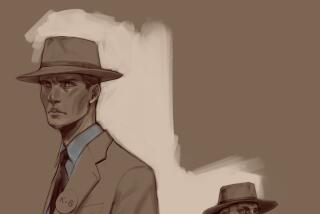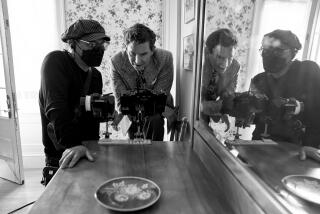Working Hollywood: ‘Like Crazy’ chair is Ready for its close-up
In the romantic drama “Like Crazy,” Anton Yelchin plays a college kid with a knack for making furniture who gives his British-born sweetheart (Felicity Jones) an unusual gift of love: a chair. Given the special role the chair plays in the film, it comes as no surprise that its creators, Dakota Witzenburg and Chad Petersen, have been perfecting its design since 2003.
“I’ve always been that do-it-yourself type of person,” said Witzenburg. “I really like nice things and prefer quality over quantity.”
Raised in Indianola, Iowa, Witzenburg grew up watching his parents make things. His father, a contractor, built houses, and his mother sewed him shorts and other clothing. He studied studio art at Linfield College in McMinnville, Ore., before heading to USC for a graduate degree in sculpture. After graduation, he and business partner Petersen founded todosomething, a Los Angeles-based custom design and fabrication studio that specializes in furniture and cabinetry.
Long before “Like Crazy” went into production, Witzenburg and the film’s cowriter Ben York Jones had met at parties through a mutual friend. When it came time to roll cameras, the filmmakers remembered todosomething’s signature chair. Todosomething’s furniture now has appeared on ABC’s “Private Practice” in addition to “Like Crazy,” which won the grand jury prize for best picture at the Sundance Film Festival in January and was released in Los Angeles theaters on Friday.
“There’s a lot of time involved in developing a product, and the chair is the one thing that we’ve focused on for quite a while,” said Witzenburg. “From its very beginning to the point it’s at now, we’ve just put a lot of effort into it. It’s a constant exploration of that chair and its form.”
A whole lotta shakin’: The chair from “Like Crazy” may look contemporary, but it traces its origins to 18th century England and America. “Chad and I, we are really influenced by Shaker furniture,” said Witzenburg. “There’s this aesthetic that’s really simple and beautiful and minimal, but it functions in this really great way. There’s a place for everything, and everything in its place. With Shaker peg rails, a broom or a chair can be hung up so you can sweep around the floor. I feel like a certain order and cleanliness to a room or the way that things are composed are comforting and nice.”
The drawing board: “Things will start out as basic drawings or ideas, and then we’ll translate them into computer drawings,” said Witzenburg. “Google SketchUp is a really simple program to use. Having precise drawings from a computer makes it a lot easier for us to quickly draw things and have perspective and 3-D visions, so we’d like to explore a bit more CAD [or computer-aided design]. But we’ve found that a lot of the fabricators that we work with still use the basic drawings and basic ways. So basic measurements and all these other things are still used quite a bit, whether it be for metal spinners or steel fabricators. But we also send out CAD files for some of the manufacturing that we do.”
Have a seat: The chair that Witzenburg and Petersen have iterated since 2003 began with a simple challenge. “Efficiency — to try and make something using a minimal amount of materials — is where it started,” said Witzenburg. “I wanted to figure out a way to make a table and four chairs out of two pieces of plywood, and that’s where the design came out of. I made that prototype, and since then, we’ve been developing it over time, making newer versions and figuring out other ways to make them. It’s pretty much like an artist who makes a painting over and over. As we’ve been going along, we’re just determined that certain things could be improved upon. And like a painter or a sculptor making something over and over, we’ve developed a relationship with that object, studying and practicing to get to a better point. That investigation of the chair itself is where we’re coming from with it.”
Thoroughly modern milling: “We’re really focusing more on the design of things and trying to figure out how to have things made more efficiently using more contemporary methods,” said Witzenburg. “Like the chair — originally, I made it using my own templates and routers, and since then, we’ve started using a CNC machine, which allows us to cut out more perfect pieces [using computer numerical control]. There’s still a lot of handwork that’s involved in it, but using modern technology allows us to make better things less expensively. We do prototyping and figuring out things and then find other people who can make them faster with better tools or more modern technology.”
More to Read
The biggest entertainment stories
Get our big stories about Hollywood, film, television, music, arts, culture and more right in your inbox as soon as they publish.
You may occasionally receive promotional content from the Los Angeles Times.






